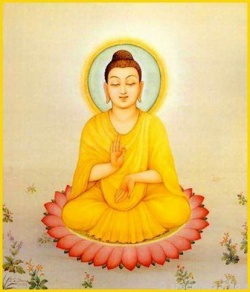Difference between revisions of "Buddhism of the harvest"
(Created page with "thumb|250px| <poem> Buddhism of the harvest [脱益仏法] ( Jpn datchaku-buppo ) The Buddhism directed toward the salvation of those who received ...") |
|||
| (2 intermediate revisions by 2 users not shown) | |||
| Line 1: | Line 1: | ||
[[File:Boo30tbb.jpg|thumb|250px|]] | [[File:Boo30tbb.jpg|thumb|250px|]] | ||
<poem> | <poem> | ||
| − | Buddhism of the harvest | + | [[Buddhism of the harvest]] |
| − | [脱益仏法] ( Jpn datchaku-buppo ) | + | [[脱益仏法]] ( Jpn [[datchaku-buppo]] ) |
| − | The Buddhism directed toward the salvation of those who received the seeds of Buddhahood in their lives through the practice of Buddhism in their past existences. The process by which | + | The [[Buddhism]] directed toward the {{Wiki|salvation}} of those who received the [[seeds]] of [[Buddhahood]] in their [[lives]] through the practice of [[Buddhism]] in their past [[existences]]. The process by which The [[Buddha]] leads [[people]] to [[Enlightenment]] may be divided into three stages called sowing, maturing, and harvesting. This process is described in the [[Lotus Sutra]].[[Shakyamuni]] first planted the [[seeds]] of [[Enlightenment]] in the [[lives]] of his [[disciples]] at the [[time]] of his original [[Enlightenment]] numberless major [[World]] system dust {{Wiki|particle}} [[Kalpas]] in the past, as expounded in the "[[Life Span]]" (sixteenth) chapter, and then nurtured the [[seeds]] through his preaching as the sixteenth son of The [[Buddha Great Universal Wisdom Excellence]] at a [[time]] major [[World]] system dust {{Wiki|particle}} [[Kalpas]] in the past, as related in the "[[Parable of the Phantom City]]" (seventh) chapter. |
| + | |||
| + | He continued nourishing the [[seeds]] in his [[lifetime]] in [[India]] through the [[provisional teachings]] he expounded during the forty-two years after his [[Enlightenment]] under the [[Bodhi tree]] as well as through the {{Wiki|theoretical}} [[teaching]] (first fourteen chapters) of the [[Lotus Sutra]]. Finally he brought his [[disciples]] to full [[Enlightenment]] with the [[essential]] [[teaching]] (latter fourteen chapters) of the [[Sutra]], particularly the "[[Life Span]]" chapter. Therefore the [[essential]] [[teaching]] of the [[Lotus Sutra]] is called the [[Buddhism of the harvest]].In contrast, [[Nichiren]]'s [[teaching]] is called the [[Buddhism of sowing]] because it implants the [[seeds]] of [[Buddhahood]], i.e., [[Nam-myoho-rengekyo]], in the [[lives]] of the [[people]] of the [[Latter Day of the Law]], who had not received the [[seeds]] in the past. | ||
| + | |||
| + | See also; [[Buddhism of sowing]]. | ||
</poem> | </poem> | ||
{{R}} | {{R}} | ||
Latest revision as of 06:21, 8 November 2013
Buddhism of the harvest
脱益仏法 ( Jpn datchaku-buppo )
The Buddhism directed toward the salvation of those who received the seeds of Buddhahood in their lives through the practice of Buddhism in their past existences. The process by which The Buddha leads people to Enlightenment may be divided into three stages called sowing, maturing, and harvesting. This process is described in the Lotus Sutra.Shakyamuni first planted the seeds of Enlightenment in the lives of his disciples at the time of his original Enlightenment numberless major World system dust particle Kalpas in the past, as expounded in the "Life Span" (sixteenth) chapter, and then nurtured the seeds through his preaching as the sixteenth son of The Buddha Great Universal Wisdom Excellence at a time major World system dust particle Kalpas in the past, as related in the "Parable of the Phantom City" (seventh) chapter.
He continued nourishing the seeds in his lifetime in India through the provisional teachings he expounded during the forty-two years after his Enlightenment under the Bodhi tree as well as through the theoretical teaching (first fourteen chapters) of the Lotus Sutra. Finally he brought his disciples to full Enlightenment with the essential teaching (latter fourteen chapters) of the Sutra, particularly the "Life Span" chapter. Therefore the essential teaching of the Lotus Sutra is called the Buddhism of the harvest.In contrast, Nichiren's teaching is called the Buddhism of sowing because it implants the seeds of Buddhahood, i.e., Nam-myoho-rengekyo, in the lives of the people of the Latter Day of the Law, who had not received the seeds in the past.
See also; Buddhism of sowing.
